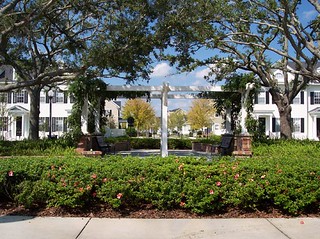Turning abandoned and obsolete properties into "park-oriented development"

Posted April 20, 2012 at 1:29PM
One of the problems I have with a lot of what passes for smart infill development – on the whole, a good thing – is that parks and green space are treated as afterthoughts at best, and frequently ignored altogether. And one of the problems I have with park advocacy is that many park advocates are only interested in the green space, and frequently instead of development rather than in support of it. Both approaches seem wrong to me: the environmental advantages of urban density are such that we need more, not less, city development; but our cities also need more green space, especially as we add new residents or businesses. We humans need a connection to nature.
So why not do both at the same time? I feel silly even writing that because it is so obvious. But in my experience it almost never happens.
Infill developers frequently work with small parcels, without much if any room for green space; and, even if room can be found, providing what is essentially a free public amenity in lieu of additional housing or business property cuts into already thin profit margins. They, like far too many smart growth advocates, see parks as someone else’s worry. Park advocates, for their part, frequently distrust residential and commercial development of any sort. Rather, they see their job as preventing new development from crowding city neighborhoods.
 An exception to the latter is my friend Peter Harnik, director of the Center for City Park Excellence at the Trust for Public Land and author of Urban Green. Peter believes that parks and urban density can have a healthy symbiotic relationship. Parks near density are better cared for and provide benefits to more people; city homes and businesses near parks enjoy higher property values and soften urban hardscape. (If well designed, parks also help filter stormwater before it becomes runoff.)
An exception to the latter is my friend Peter Harnik, director of the Center for City Park Excellence at the Trust for Public Land and author of Urban Green. Peter believes that parks and urban density can have a healthy symbiotic relationship. Parks near density are better cared for and provide benefits to more people; city homes and businesses near parks enjoy higher property values and soften urban hardscape. (If well designed, parks also help filter stormwater before it becomes runoff.)
The combined municipal government of Miami and Dade County, Florida seems to agree. The parks department wants to find investors willing to take vacant and obsolete properties such as old strip malls and turn them into updated housing, commercial property, and public parks, as part of the same concept. For a 10-acre parcel, for example, the idea would be to use two or three acres for immediate green space, reserving the rest for mixed-use development. The presence of the park would attract people and raise the value of the adjacent land for development.
Jack Kardys of the parks and recreation department told a local TV station that the county was looking for "those car lots, those strip malls, those places that have gone out of business in those commercial corridors” in order to allow investors to work with the county to purchase and convert them “into a park-centric, mixed-use development." Sasha Andrade, a reporter for Local 10 television, writes that the department is hoping to find a spot near a bus stop, transit station, or in a lower income community to test the idea. If it works, the county will pursue additional locations.
 The larger vision of the parks department is to create public green space within walking distance of every resident. (There’s a short video about the new initiative on the TV site, but the station doesn’t allow me to embed it here.)
The larger vision of the parks department is to create public green space within walking distance of every resident. (There’s a short video about the new initiative on the TV site, but the station doesn’t allow me to embed it here.)
The idea of taking foreclosed or outmoded property and converting it into what I’m calling park-oriented development builds on ideas pioneered elsewhere, such as Philadelphia’s Green2015, which seeks to add hundreds of acres of park land by greening vacant and blighted properties. (The Philadelphia Horticultural Society also has a program to green blighted lots.) Atlanta has piloted an idea supported by the Speedwell Foundation to turn foreclosed commercial property into parks (“Redfields to Greenfields”).
But what seems special about the Miami-Dade concept is that mixed-use development is also a major part of the plan, from the beginning. This brings two of our most pressing urban needs together in the same package, a win-win worth rooting for.
Related posts:
- New wetlands park replaces brownfield in distressed neighborhood (February 27, 2012)
- How parks can help revitalize distressed neighborhoods (March 16, 2011)
- 'Peace Gardens' bring needy communities together, 'saving our own neighborhood' (August 9, 2010)
- Great short video on greening smart growth with living nature (August 17, 2009)
Move your cursor over the images for credit information.
Please also visit NRDC’s Sustainable Communities Video Channel.
